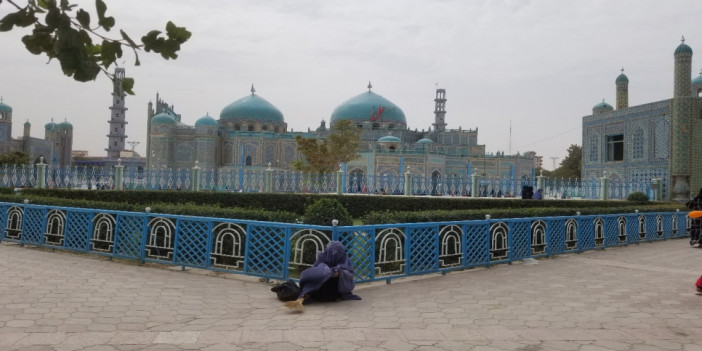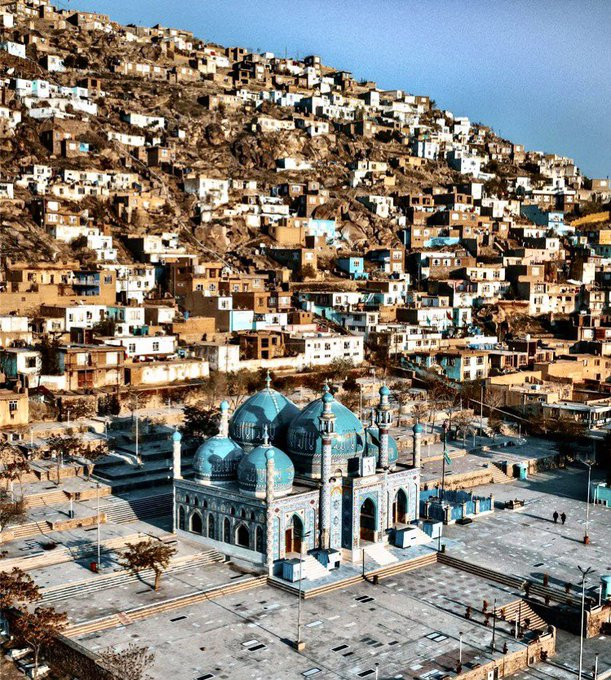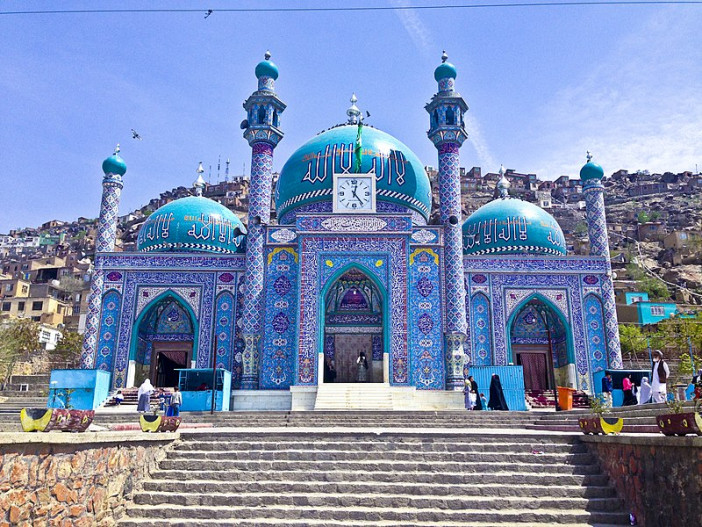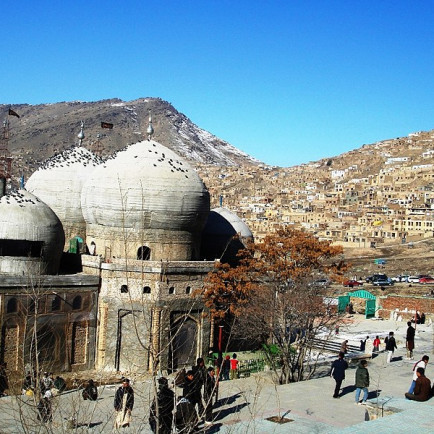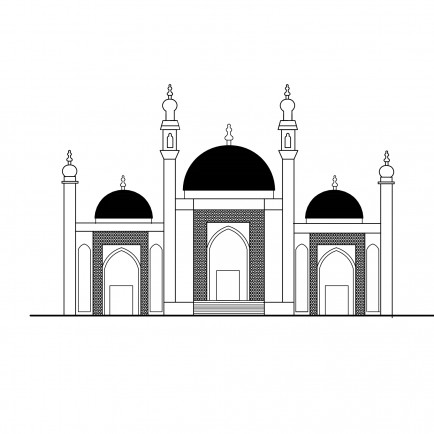Sakhi Shrine Mosque
History
It is believed that the shrine marks the spot where the cloak of Muhammad was kept on its way to its present location in the Shrine of the Cloak in Kandahar. The cloak is said to have been woven by Muhammad himself with the help of his daughter Fatima, her husband, and Muhammad's cousin, Ali, and their sons, Hasan and Husayn. Before Muhammad died, he bequeathed his cloak to Uwais al-Qarani, telling Ali and Umar that Uwais should be given the cloak on his death. After the Muhammad's death, Uwais took the cloak to the Cave of Hira on Jabal al-Nour, where Muhammad received his first revelation. It is believed to have remained in the cave until it was taken to Baghdad by Shaykh al-Uliya Qutba al-Atqiya. Timur would later seize it and take to his capital of Samarqand, where is would stay until 1076/1665-66. The cloak was then taken to India, from where it was taken to Balkh, in the west of today's Afghanistan, by the then governor of the city, Mir Yar Beg. He built a fort in Juzgun, Badakhshan, to house the garment securely. Following the move of the cloak to Juzgun, the settlement became known as Fayzabad. The cloak would remain there for seventy-nine years. In 1181/1767-8, Ahmad Shah Durrani decided to move the cloak to his capital of Kandahar. He entrusted the move to Shah Wali Khan E'temad al-Dawla. The cloak was taken on its journey by a group of the most pious men. Kabul was on the route south from Fayzabad, and it was near the edge of the town that the group stopped to rest and allow local people to view the cloak. One day, the men carrying the cloak noticed a man wearing green praying by it. On the third night, they dreamt that the man in green came to see the cloak once more. When he removed his sword from its sheath and placed it on a nearby rock they noticed that its blade had a double tip. They recognised the sword as Zulfiqar and its owner as Imam Ali. The rock on which Ali is believed to have placed his sword is now encompassed by the shrine building. When the men awoke, they knew that a shrine should be built on this spot. Ahmad Shah patronised the building of the first structure, with one dome over the rock. The cloak remained here for eight months, before continuing its journey south to Kandahar, where it remains today. It was notably brought out of its shrine and worn by Mullah Omar in 1996.
Urban and Architectural
The shrine is decorated with glazed tiles in a neo-Safavid Persian style. The building bears many inscriptions, including dedicatory texts, Qurʾanic excerpts, prayers, Hadith, and poetry. A second dome was added to the shrine by the mother of Amanullah Khan in 1919. The four additional domes were added during renovations which took place between 2008 and 2016.
Description
The Sakhi Shrine is one of the more beautiful and artistic of mosques. With its bright colours and popular status as a hangout spot for all the people of Kabul, this mosque stands out a lot.
The Sakhi Shrine is not without its own bloody past, as are most things in Kabul. Due to its popularity. The shrine is located at the foot of the Asmayi Hill, now better known as Television Hill. To its north and west is the Sakhi Cemetery. the Shrine has been targeted during the wars and even after it by terrorists. There have been numerous shootings in the mosque, but thankfully none of them have proven successful to remove the mosque as one of the hotspots of the city. The mosque, due to its unusual design and colours, is also popular with all the tourists, because whenever tourists see or think about a mosque, they picture a bland white building that is beautiful solely because of the architecture. Sakhi Shrine continues to prove them wrong and capture the minds and hearts of locals and tourists alike. The shine is also popular for young Afghanis to come and take lots of pictures there, or to relax on the cool marble floors of the Shrine.
References
https://www.travellingfoot.com/best-places-to-visit-in-afghanistan/tourist-attractions-in-kabul/sakhi-shrine. https://twitter.com/baytalfann/status/1569260077860651008. https://rukhshana.com/en/female-visitors-of-sakhi-shrine-in-mazar-e-sharif-criticize-the-talibans-restrictions. https://www.shutterstock.com/search/sakhi-mosque. https://en.wikipedia.org/wiki/Sakhi_Shrine
Details
Location
Kabul, Afghanistan
Drawings
Map
History
It is believed that the shrine marks the spot where the cloak of Muhammad was kept on its way to its present location in the Shrine of the Cloak in Kandahar. The cloak is said to have been woven by Muhammad himself with the help of his daughter Fatima, her husband, and Muhammad's cousin, Ali, and their sons, Hasan and Husayn. Before Muhammad died, he bequeathed his cloak to Uwais al-Qarani, telling Ali and Umar that Uwais should be given the cloak on his death. After the Muhammad's death, Uwais took the cloak to the Cave of Hira on Jabal al-Nour, where Muhammad received his first revelation. It is believed to have remained in the cave until it was taken to Baghdad by Shaykh al-Uliya Qutba al-Atqiya. Timur would later seize it and take to his capital of Samarqand, where is would stay until 1076/1665-66. The cloak was then taken to India, from where it was taken to Balkh, in the west of today's Afghanistan, by the then governor of the city, Mir Yar Beg. He built a fort in Juzgun, Badakhshan, to house the garment securely. Following the move of the cloak to Juzgun, the settlement became known as Fayzabad. The cloak would remain there for seventy-nine years. In 1181/1767-8, Ahmad Shah Durrani decided to move the cloak to his capital of Kandahar. He entrusted the move to Shah Wali Khan E'temad al-Dawla. The cloak was taken on its journey by a group of the most pious men. Kabul was on the route south from Fayzabad, and it was near the edge of the town that the group stopped to rest and allow local people to view the cloak. One day, the men carrying the cloak noticed a man wearing green praying by it. On the third night, they dreamt that the man in green came to see the cloak once more. When he removed his sword from its sheath and placed it on a nearby rock they noticed that its blade had a double tip. They recognised the sword as Zulfiqar and its owner as Imam Ali. The rock on which Ali is believed to have placed his sword is now encompassed by the shrine building. When the men awoke, they knew that a shrine should be built on this spot. Ahmad Shah patronised the building of the first structure, with one dome over the rock. The cloak remained here for eight months, before continuing its journey south to Kandahar, where it remains today. It was notably brought out of its shrine and worn by Mullah Omar in 1996.
Urban and Architectural
The shrine is decorated with glazed tiles in a neo-Safavid Persian style. The building bears many inscriptions, including dedicatory texts, Qurʾanic excerpts, prayers, Hadith, and poetry. A second dome was added to the shrine by the mother of Amanullah Khan in 1919. The four additional domes were added during renovations which took place between 2008 and 2016.
Description
The Sakhi Shrine is one of the more beautiful and artistic of mosques. With its bright colours and popular status as a hangout spot for all the people of Kabul, this mosque stands out a lot.
The Sakhi Shrine is not without its own bloody past, as are most things in Kabul. Due to its popularity. The shrine is located at the foot of the Asmayi Hill, now better known as Television Hill. To its north and west is the Sakhi Cemetery. the Shrine has been targeted during the wars and even after it by terrorists. There have been numerous shootings in the mosque, but thankfully none of them have proven successful to remove the mosque as one of the hotspots of the city. The mosque, due to its unusual design and colours, is also popular with all the tourists, because whenever tourists see or think about a mosque, they picture a bland white building that is beautiful solely because of the architecture. Sakhi Shrine continues to prove them wrong and capture the minds and hearts of locals and tourists alike. The shine is also popular for young Afghanis to come and take lots of pictures there, or to relax on the cool marble floors of the Shrine.


